I’m looking for a good leftie upside down shoulder holster for my 340PD and am concerned about the gun falling out under normal wear. At my age (71) & physical condition I can’t run and fist fighting to defend myself is unrealistic. Any input is appreciated.
You are using an out of date browser. It may not display this or other websites correctly.
You should upgrade or use an alternative browser.
You should upgrade or use an alternative browser.
Upside Down Shoulder Holster Recommendation?
- Thread starter Old cop
- Start date
Register to hide this ad
Skeptic 9c
Member
Check the Galco line of shoulder rigs. It can be uncomfortable in the Miami heat, despite what you saw on TV. It does require some adjustment.
Geoff
Who wonders why some smart entrepreneur hasn't started a touring company to sell and fit holsters to guns owners and all at shows and big gun shops. I know LIABILITY!
Geoff
Who wonders why some smart entrepreneur hasn't started a touring company to sell and fit holsters to guns owners and all at shows and big gun shops. I know LIABILITY!
I recommend the Bianchi 9R. This old one of mine still has a firm grip
on the gun. Its shown with Colt's Agent. It might not be easy to find a
left handed one, but I don't know why ambi-dexterous wouldn't work.
But you would probably need to re-work the harness. Maybe Red Nichols
will jump in here. He designed the 9R & 9R2, so he can give you some
good advice.
on the gun. Its shown with Colt's Agent. It might not be easy to find a
left handed one, but I don't know why ambi-dexterous wouldn't work.
But you would probably need to re-work the harness. Maybe Red Nichols
will jump in here. He designed the 9R & 9R2, so he can give you some
good advice.
Attachments
ContinentalOp
Member
- Joined
- Apr 14, 2009
- Messages
- 6,315
- Reaction score
- 12,812
I have no experience with them, but you might want to check out the products by Ken Null and Alessi. They both make upside-down shoulder holsters that should work with your 340. They have good reputations.
THE PILGRIM
Member
Bianchi's 9R series is ambidextrous. Harness need be switched around or replicated as mirror image of OEM harness. I own two 9Rs, one with L-H harness, one with R-H harness. . . . But wait! There's more!! 9R series (R1 and R2 only) is also an ambidextrous break-front strong side hip holster that affixes on up to 1.5-inch belts.
Depending upon specific version, 9Rs function correctly with a large number of revolvers that otherwise should not be used with the same holster.
By way of example, my 9R2s accept my three-inch Ruger SP101. Rugers are not supposed to work - but they do. Holster is supposed to accept up to 2.5-inch barrels. My three-incher works perfectly. And on, and on.
These shoulder holsters are marvelous. Since they have been out of production for decades, you may be able to acquire one for substantially less than a currently manufacturef shoulder holster that is less functional.
One last feature, Red Nichols designed the R1 and R2 series.
Hope something in this mishmash helps.
Depending upon specific version, 9Rs function correctly with a large number of revolvers that otherwise should not be used with the same holster.
By way of example, my 9R2s accept my three-inch Ruger SP101. Rugers are not supposed to work - but they do. Holster is supposed to accept up to 2.5-inch barrels. My three-incher works perfectly. And on, and on.
These shoulder holsters are marvelous. Since they have been out of production for decades, you may be able to acquire one for substantially less than a currently manufacturef shoulder holster that is less functional.
One last feature, Red Nichols designed the R1 and R2 series.
Hope something in this mishmash helps.
ldausmc1369
US Veteran
A Galco 156 works for both my J frame and 642. Takes some adjusting and wearing to get exactly right.
THE PILGRIM
Member
A while back, a brilliant forum member coined the phrase ‘J Boy.’
Yes, Father, I am a J Boy.
I did not know the 9Rs were switch hitters.
Wouldn’t mind having one for my J Frames.
Yes, Father, I am a J Boy.
I did not know the 9Rs were switch hitters.
Wouldn’t mind having one for my J Frames.
OP will likely have to go to one of the smaller semi custom holster makers for the 340PD, none of the vintage holsters is likely to fit correctly. I had the elastic cloth material replaced on a Bucheimer upside down shoulder holster, the person who did it also added a retaining strap for additional safety. Doubtful a handgun will fall out of a holster that uses the metal clamshell design.
Check out Craft Holsters.
I just ordered one of theirs for my Beretta Cougar and I’m really pleased with it.
No matter what angle I have it adjusted to the gun will not fall out. The nice thing is that they made this to come off the harness and it can be used as a belt holster!
I just ordered one of theirs for my Beretta Cougar and I’m really pleased with it.
No matter what angle I have it adjusted to the gun will not fall out. The nice thing is that they made this to come off the harness and it can be used as a belt holster!
I recommend the Bianchi 9R. This old one of mine still has a firm grip
on the gun. Its shown with Colt's Agent. It might not be easy to find a
left handed one, but I don't know why ambi-dexterous wouldn't work.
But you would probably need to re-work the harness. Maybe Red Nichols
will jump in here. He designed the 9R & 9R2, so he can give you some
good advice.
I have one and I carried a Model 60 in it for years. (mid 1970s) Left will be harder to find. With that said its not hard to make a good and fast draw from the off hand so a right handed holster might work for the OP. FWIW those holsters, at least for my J Frame are extremely picky about what grips are on the gun. In my case I stuck with the stock factory grips gun came with.
michpatriot
Member
- Joined
- Apr 10, 2017
- Messages
- 328
- Reaction score
- 479
Bianchi 9r
The Bianchi #209 fits the magnum frame j snug..real secure if you ask me. Don't even know the 340 is there most of the time. I'll usually carry the PD in my pocket and the MP340 that I fitted with a titanium cylinder in the shoulder rig as my either/or setup..great carry combo, gives you options sitting or standing having both holster positions. I carried all day today with this combination downtown Detroit on a family trip to the DNR outdoor center, what a breeze to carry two j frames this way.
The Bianchi #209 fits the magnum frame j snug..real secure if you ask me. Don't even know the 340 is there most of the time. I'll usually carry the PD in my pocket and the MP340 that I fitted with a titanium cylinder in the shoulder rig as my either/or setup..great carry combo, gives you options sitting or standing having both holster positions. I carried all day today with this combination downtown Detroit on a family trip to the DNR outdoor center, what a breeze to carry two j frames this way.
Last edited:
rednichols
Member
The forum has reviewed upside down holsters more than once. The original was Berns-Martin's "Lightin" (no 'g'), famous not least for being intended as James Bond's shoulder holster -- for the then-new Centennial -- and being specified for the Walter PPK that was being discussed with the author as being a European baddies gun.
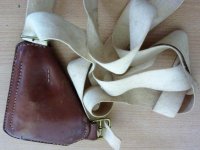
The most knowledgeable about the B-M's peculiar history is turnerriver. In general, though, the market began there and was supplanted by the elastic form, apparently created by Wally Wolfram by the early 1960s. John Bianchi and Neale Perkins both copied it, Bucheimer and everyone else jumped in -- and then the pistols started falling out. No maker except John realised why and gave them up.
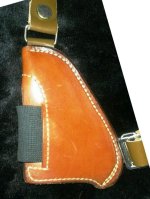
The Bianchi elastic version was called the #9. Avoid these, whether new or a half-century old as they are now. It was replaced by the #9R, the letter to distinguish it from the old. During development it was code-named 'baby 27' as it was derived from the new police duty holster with wire-form spring and internal cylinder pockets.
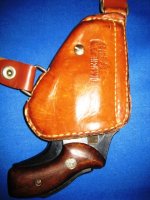
Still fell out, so an equivalent to the B-M internal spacer at the muzzle was added (one person on this forum actually owns one of the originals without it) -- and the guns stopped falling out even under a harsh test we developed to sort the good from the bad.
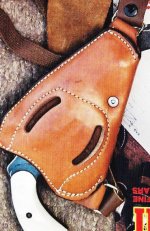
The best of them, if I do say so myself, then, was the #9R-1 and -2. I 'think' the difference in the numbers refers to a change in the spring itself; unsure because it was a long bloody time ago. Both, though, are visually distinguishable from the #9R and the #9. The early #9R is shown in crazyphil's post, and the -1 or -2 is shown in at least one other here.
Leftie harness: in a jam, leave the setup assembled for right hand and just -- put it on backwards; that is, put your right arm through the leather harness yoke and the left arm through the elastic cross strap. Work exactly like a left hand harness because that's all a leftie is: the leather was turned over on the clicker machine, and the same die is used to punch it out.
The holster itself is literally the same for left and right; and the belt slots are even rh/lh. We were quite obsessed with ambidextrous holsters because (1) JB is left handed and (2) it reduced stocking units (called 'skus').
Looking up the OP's pistol tells me it is a Centennial in size; i.e., it still has a five shot cylinder. The muzzle of the revolver is a bit larger, so one might even prefer the Detective Special version which was always moulded 'round the 'new' (how old am I) Dick Special with the longer, bulkier barrel and ejector rod shroud.
Bianchi doesn't make it now, so one would find it on eBay, for example. Things to watch out for: you want the 'lips' of the holster closure to be aligned; when the spring goes 'wonky' inside the holster shifts out of alignment; and you want assurance that the spring itself hasn't already snapped at the muzzle end; and you want assurance that a finger snapped through the opening still makes a loud 'pop' to tell you that the earlier owners haven't 'sprung' it trying to get a faster draw.
Alternatively, there is ONE elastic shoulder holster that actually works: the Bianchi 209 (in soft harness leather and 208 (same holster but constructed from thin saddle leather). The former is far more commonly found on auction sites.

Whew, I just wrote an encyclopaedia entry. Mit pics.

The most knowledgeable about the B-M's peculiar history is turnerriver. In general, though, the market began there and was supplanted by the elastic form, apparently created by Wally Wolfram by the early 1960s. John Bianchi and Neale Perkins both copied it, Bucheimer and everyone else jumped in -- and then the pistols started falling out. No maker except John realised why and gave them up.

The Bianchi elastic version was called the #9. Avoid these, whether new or a half-century old as they are now. It was replaced by the #9R, the letter to distinguish it from the old. During development it was code-named 'baby 27' as it was derived from the new police duty holster with wire-form spring and internal cylinder pockets.

Still fell out, so an equivalent to the B-M internal spacer at the muzzle was added (one person on this forum actually owns one of the originals without it) -- and the guns stopped falling out even under a harsh test we developed to sort the good from the bad.

The best of them, if I do say so myself, then, was the #9R-1 and -2. I 'think' the difference in the numbers refers to a change in the spring itself; unsure because it was a long bloody time ago. Both, though, are visually distinguishable from the #9R and the #9. The early #9R is shown in crazyphil's post, and the -1 or -2 is shown in at least one other here.
Leftie harness: in a jam, leave the setup assembled for right hand and just -- put it on backwards; that is, put your right arm through the leather harness yoke and the left arm through the elastic cross strap. Work exactly like a left hand harness because that's all a leftie is: the leather was turned over on the clicker machine, and the same die is used to punch it out.
The holster itself is literally the same for left and right; and the belt slots are even rh/lh. We were quite obsessed with ambidextrous holsters because (1) JB is left handed and (2) it reduced stocking units (called 'skus').
Looking up the OP's pistol tells me it is a Centennial in size; i.e., it still has a five shot cylinder. The muzzle of the revolver is a bit larger, so one might even prefer the Detective Special version which was always moulded 'round the 'new' (how old am I) Dick Special with the longer, bulkier barrel and ejector rod shroud.
Bianchi doesn't make it now, so one would find it on eBay, for example. Things to watch out for: you want the 'lips' of the holster closure to be aligned; when the spring goes 'wonky' inside the holster shifts out of alignment; and you want assurance that the spring itself hasn't already snapped at the muzzle end; and you want assurance that a finger snapped through the opening still makes a loud 'pop' to tell you that the earlier owners haven't 'sprung' it trying to get a faster draw.
Alternatively, there is ONE elastic shoulder holster that actually works: the Bianchi 209 (in soft harness leather and 208 (same holster but constructed from thin saddle leather). The former is far more commonly found on auction sites.

Whew, I just wrote an encyclopaedia entry. Mit pics.
TomkinsSP
Member
Bianchi 9r2.
The OP wrote: “Any input is appreciated.”. He is 71.
I am going to be 76 on 4/27, if I live that long. I can assure the OP and everyone that age does not dictate the choice of a holster. Anyway, I am speaking to the OP and everyone else is listening in and some will be weighing in. That I’d come with me and based upon the OP’s remark it seems fine with him.
The choice of holster that carries the gun in a position that has to,overcome gravity is counterintuitive to best self defense practices. The only thing that keeps the gun from falling to the ground is some sort of active retention device. That device will never be foolproof. Consider that the position of the holstered gun will be barrel pointed up at your armpit. Add to that the fat that drawing in the gun from the holster will require some distortion of the hand and wrist affecting grip and control, and you have a recipe for disaster by death or a shoulder and arm that will never work again.
Polite writers would say that using a shoulder that suspends the gun upside down is “counterintuitive.” Jarhead senior noncommissioned do not mince words. To me counterintuitive means either thoughtless or crazy.
There are so many good carry options today to choose from that considering selecting what has to be the worst option for safety seems misinformed.
Dear OP, I rarely write as boldly as I have in this post. Please do not take it personally and please reconsider your choice. This forum is full of some of the most knowledgeable people on the widest range of gun related topics. If you describe what condition leads you to consider the upside down holster, I am certain that some here will grasp it and provide better solutions.
I am going to be 76 on 4/27, if I live that long. I can assure the OP and everyone that age does not dictate the choice of a holster. Anyway, I am speaking to the OP and everyone else is listening in and some will be weighing in. That I’d come with me and based upon the OP’s remark it seems fine with him.
The choice of holster that carries the gun in a position that has to,overcome gravity is counterintuitive to best self defense practices. The only thing that keeps the gun from falling to the ground is some sort of active retention device. That device will never be foolproof. Consider that the position of the holstered gun will be barrel pointed up at your armpit. Add to that the fat that drawing in the gun from the holster will require some distortion of the hand and wrist affecting grip and control, and you have a recipe for disaster by death or a shoulder and arm that will never work again.
Polite writers would say that using a shoulder that suspends the gun upside down is “counterintuitive.” Jarhead senior noncommissioned do not mince words. To me counterintuitive means either thoughtless or crazy.
There are so many good carry options today to choose from that considering selecting what has to be the worst option for safety seems misinformed.
Dear OP, I rarely write as boldly as I have in this post. Please do not take it personally and please reconsider your choice. This forum is full of some of the most knowledgeable people on the widest range of gun related topics. If you describe what condition leads you to consider the upside down holster, I am certain that some here will grasp it and provide better solutions.
gman51
Member
I have had a horizontal shoulder rig and hated how it didn't conceal worth a darn. I gave it away and bought a vertical shoulder rig and like it a lot. I wouldn't trust an upside down rig and I have no idea how the gun stays in the holster or what the purpose is for an upside down rig.
rednichols
Member
RichardW is, of course, quite right in a literal sort of way. And I'm the very first to remind that safety isn't about eliminating risk; it's about the elimination of unnecessary risks; because some risks are absolutely necessary in certain roles of society (a soldier takes risks that I would never take, as they are unnecessary for me; but they are necessary for him).
My replies in this thread are directed to the restriction of considering 'upside down shoulder holsters'. My personal preference in concealment weapons is not to carry at all; on the other hand, in my environment it's really not a choice but a requirement: no guns here, even the coppers are prohibited from carrying off-duty.
So: 'why' upside down shoulder holsters at all? The original, the B-M, was designed and made for only small revolvers and with very short barrels. That meant 2" J, 2" D, and eventually 3" in both and I think even the M&P might have been added.
I personally would not rely on a B-M of any age. But if I were Bond, and someone handed me one with a loaded 2" .38 Special in it and said, "that's all I've got", I'd be grateful for it!
The upside down holster was supposed to, and does, provide a natural draw that is a sort of 'snatch and shoot' from across the chest. It was meant to accomplish this, by reversing the traditionally difficult way to draw (butt up and forward) and to conceal, by turning the grip to the rear. Perhaps Myres was first to 'think outside the box' with this patented holster by son Bill Myres.
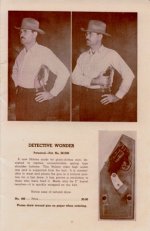
So the B-M was issued with a specific set of instructions about where it was to be worn, and that was not under the armpit: between the armpit and the nipple. Yes, drawing it would direct the muzzle back to the shoulder because to be secure, it is designed to require the pistol be 'levered' out.
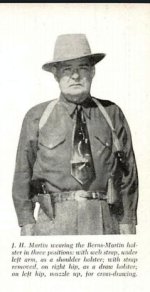 This is Jack Martin himself.
This is Jack Martin himself.
So (again), carried pointed away from the wearer, and everyone else except directly above in a multi-story situation, at all times except during the draw which, in an expert, is fractions of a single second.
On the other hand, if one doesn't have a good one (including elastic versions made to this very day by folks who don't understand the physics of the situation) one is risking it falling out every minute you're wearing it! That's bad.
The physics of the old #9R are such that it can't fall out. Ever. Under our gravitational limitations. Dunno about high g's such as a fighter jet launch. If you fly fighter jets, please don't listen to me and instead get your instructions from much higher up.
The 9R, and the better #9R-1 and -2, came about for the very reason that's being queried: an LEO jumped a fence wearing the original #9 and out popped the revolver! So we developed a test that it couldn't pass in the 'lab' (my office) and built a holster that would pass that, and an even greater extreme: we called it 'the snap test'.
I've covered the snap test before; will again if someone insists. But it's quite a boring enunciation and few will actually do it anyway. But those who do, with aged #209s and #9Rs, report 100% passes for them of this test. NO other brand of upside down holster will pass it. In fact, no vertical spring shoulder holster will pass it: takes a safety strap to pass a shoulder holster snap test unless it's a #9R or a #209.
When I carried, in USA with a permit in CA when those were v,v rare, I carried a 44 Bulldog in a #9R (-1 or -2 I dunno). Would do it again. It had the side benefit of being proof against my young children ever getting it out, because its draw is, there's the word, 'counterintuitive' until one puts it on.
My replies in this thread are directed to the restriction of considering 'upside down shoulder holsters'. My personal preference in concealment weapons is not to carry at all; on the other hand, in my environment it's really not a choice but a requirement: no guns here, even the coppers are prohibited from carrying off-duty.
So: 'why' upside down shoulder holsters at all? The original, the B-M, was designed and made for only small revolvers and with very short barrels. That meant 2" J, 2" D, and eventually 3" in both and I think even the M&P might have been added.
I personally would not rely on a B-M of any age. But if I were Bond, and someone handed me one with a loaded 2" .38 Special in it and said, "that's all I've got", I'd be grateful for it!
The upside down holster was supposed to, and does, provide a natural draw that is a sort of 'snatch and shoot' from across the chest. It was meant to accomplish this, by reversing the traditionally difficult way to draw (butt up and forward) and to conceal, by turning the grip to the rear. Perhaps Myres was first to 'think outside the box' with this patented holster by son Bill Myres.

So the B-M was issued with a specific set of instructions about where it was to be worn, and that was not under the armpit: between the armpit and the nipple. Yes, drawing it would direct the muzzle back to the shoulder because to be secure, it is designed to require the pistol be 'levered' out.
 This is Jack Martin himself.
This is Jack Martin himself.So (again), carried pointed away from the wearer, and everyone else except directly above in a multi-story situation, at all times except during the draw which, in an expert, is fractions of a single second.
On the other hand, if one doesn't have a good one (including elastic versions made to this very day by folks who don't understand the physics of the situation) one is risking it falling out every minute you're wearing it! That's bad.
The physics of the old #9R are such that it can't fall out. Ever. Under our gravitational limitations. Dunno about high g's such as a fighter jet launch. If you fly fighter jets, please don't listen to me and instead get your instructions from much higher up.
The 9R, and the better #9R-1 and -2, came about for the very reason that's being queried: an LEO jumped a fence wearing the original #9 and out popped the revolver! So we developed a test that it couldn't pass in the 'lab' (my office) and built a holster that would pass that, and an even greater extreme: we called it 'the snap test'.
I've covered the snap test before; will again if someone insists. But it's quite a boring enunciation and few will actually do it anyway. But those who do, with aged #209s and #9Rs, report 100% passes for them of this test. NO other brand of upside down holster will pass it. In fact, no vertical spring shoulder holster will pass it: takes a safety strap to pass a shoulder holster snap test unless it's a #9R or a #209.
When I carried, in USA with a permit in CA when those were v,v rare, I carried a 44 Bulldog in a #9R (-1 or -2 I dunno). Would do it again. It had the side benefit of being proof against my young children ever getting it out, because its draw is, there's the word, 'counterintuitive' until one puts it on.
Last edited:
TomkinsSP
Member
The Bianchi 9r2 hoster and a M36 is a match made in heaven. Upside down Shoulder rigs place a firearm very tight against your body, in a very consealed position with the barrel either directly in front of or behind your shoulder, the cylinder and trigger under your armpit and the butt in the hollow below.
Wearing a suit, the gun just disappears. Drawing is very natural. On the 9r2 the revolver is retained by a very strong flat spring sewn into the leather. The weight of even a steel J is held motionless, running, jumping (ah, memories, I do NOT do that anymore) will not dislodge it.
Drawing is a simple natural fluid movement. Reaching inside your jacket, strong arm gripping the square butt magna stocks you pull down and across while rotating your wrist in S&W fashion (CCW). It is almost as easy to reach up weak hand grip the butt, pull down while twisting Clockwise. Southpaws can simply wear the holster backwards.
Any crossdraw holster presents slower than a belt OWB. Any shoulder holster causes the muzzle to sweep yourself or others at least momentarily. Plenty of folks who do not place thier finger OUTSIDE the trigger guard have managed to shoot themselves regardless of holster type. (Appindix carry anyone.)
I dislike horizontal rigs for the reason that they are constantly sweeping others with a loaded firearm.
My M64 had occasion to ride around in a Bianchi 15 vertical rig from time to time, its a really nice option for a 4 inch K frame if you are dressed well. These days my M640 spends most of its time in a Shadow Pancake holster about 2:15 to 3:45 OWB, I dont wear the 9r2 so much anymore as I never wear a suit.
Wearing a suit, the gun just disappears. Drawing is very natural. On the 9r2 the revolver is retained by a very strong flat spring sewn into the leather. The weight of even a steel J is held motionless, running, jumping (ah, memories, I do NOT do that anymore) will not dislodge it.
Drawing is a simple natural fluid movement. Reaching inside your jacket, strong arm gripping the square butt magna stocks you pull down and across while rotating your wrist in S&W fashion (CCW). It is almost as easy to reach up weak hand grip the butt, pull down while twisting Clockwise. Southpaws can simply wear the holster backwards.
Any crossdraw holster presents slower than a belt OWB. Any shoulder holster causes the muzzle to sweep yourself or others at least momentarily. Plenty of folks who do not place thier finger OUTSIDE the trigger guard have managed to shoot themselves regardless of holster type. (Appindix carry anyone.)
I dislike horizontal rigs for the reason that they are constantly sweeping others with a loaded firearm.
My M64 had occasion to ride around in a Bianchi 15 vertical rig from time to time, its a really nice option for a 4 inch K frame if you are dressed well. These days my M640 spends most of its time in a Shadow Pancake holster about 2:15 to 3:45 OWB, I dont wear the 9r2 so much anymore as I never wear a suit.
Last edited:
Similar threads
- Replies
- 0
- Views
- 93
- Replies
- 19
- Views
- 2K
- Replies
- 1
- Views
- 575


